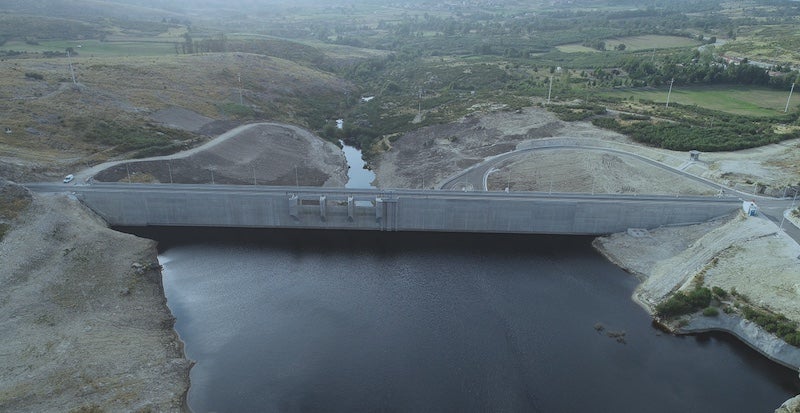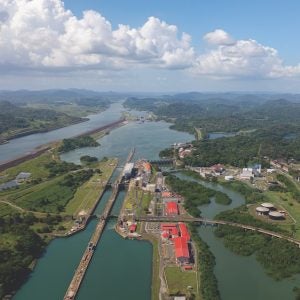
Baihetan Dam, China
The Baihetan Dam, located on the Jinsha River in Sichuan and Yunnan provinces, southwest China, is a monumental hydroelectric project. This 289m tall double-curvature arch dam with a crest elevation of 827m is the world’s second-largest hydropower project, boasting a capacity of 16GW. The dam’s construction began in 2017, and it officially opened in February 2021 at a cost of ¥220 billion (US$31.58 billion).
Equipped with 16 hydro-generating units, each with a capacity of 1GW, the Baihetan Dam is part of a clean energy corridor that includes other mega hydropower projects like the Three Gorges Dam, Wudongde Dam, Xiluodu Dam, and Xiangjiaba Dam along the same river system
The Baihetan project has had a significant impact on the region, providing thousands of jobs to local residents while necessitating the resettlement of 32 villages totalling 50,178 residents. The project also contributes to flood control, improved navigation, and sand blocking in addition to its primary function of power generation. The hydropower station became fully operational on December 20, 2022, marking a milestone in China’s clean energy initiatives.
Developed by China Three Gorges Corp. (CTG), the Baihetan project involved the construction of a concrete double-curvature arch dam with impressive specifications. The dam has a reservoir capacity of 20.627 billion cubic meters and features six flood gate structures and three spillway tunnels with a flood discharge capacity of 42,346m³/sec. CTG collaborated with Dongfang Electric Machinery Co.,Ltd. and Harbin Electric Machinery Factory for the supply of turbine generator units for this massive project.
At the end of 2023, the Baihetan Hydropower Station was recognized as one of the ‘Top 10 Engineering Achievements Globally in 2023’ by the journal “Engineering,” published by the Chinese Academy of Engineering.
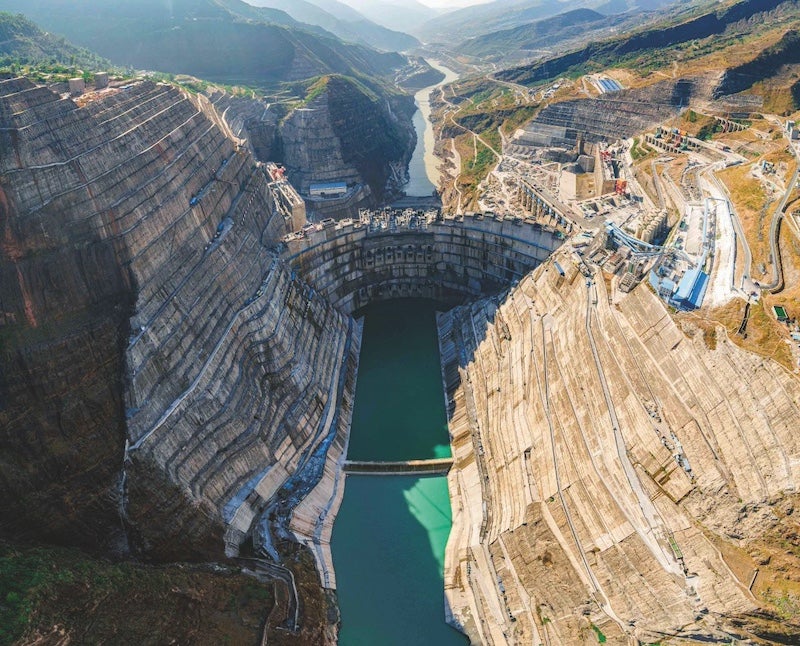
Wudongde Dam, China
The Wudongde Dam is located on the Jinsha River (an upper stretch of the Yangtze River) in southwest China. Straddling the border between Sichuan and Yunnan provinces, the project is China’s fourth-largest and the world’s seventh-largest hydropower plant.
Construction of the Wudongde Dam began in December 2015 and was completed in June 2021, with the first turbines coming online in July 2020. The dam is owned by the China Three Gorges Corporation and boasts an impressive array of statistics and engineering achievements.
Standing at 240m tall, the Wudongde Dam is one of the tallest in the world. Its design incorporates 12 turbines, each with a generating capacity of 850MW, bringing the total generating capacity to 10,200MW. This makes it capable of producing an average of 38.91 billion kilowatt-hours of electricity annually, equivalent to reducing carbon dioxide emissions by 30.5 million tons.
The dam is the world’s thinnest high arch dam and the first-ever super-high arch dam poured with low-heat cement concrete throughout the entire dam body. This innovative approach to construction has set eight world records and achieved 15 “world firsts” in hydropower engineering.
Beyond power generation, the Wudongde Dam serves multiple purposes. Its reservoir, with a normal impoundment elevation of 975 m, has a total storage capacity of 7.41 billion cubic meters and a flood control capacity of 2.44 billion cubic meters. This significant water management capability allows for seasonal regulation of water levels, providing crucial flood control benefits to the region.
The project has also been designed with environmental considerations in mind. According to China Three Gorges Corporation officials, efforts have been made to minimize the impact on migratory fish. The slowing of the river’s flow and increased depth are said to promote fish reproduction. Additionally, the project includes initiatives for water and soil conservation, as well as ecological restoration, aiming to balance environmental protection with hydropower development.
Economically, the Wudongde Dam is a cornerstone of China’s west-to-east power transmission program. It not only contributes to the country’s clean energy goals but also supports local economic development and poverty alleviation efforts. The project is expected to play a significant role in China’s ambition to reach peak carbon dioxide emissions before 2030 and achieve carbon neutrality before 2060.
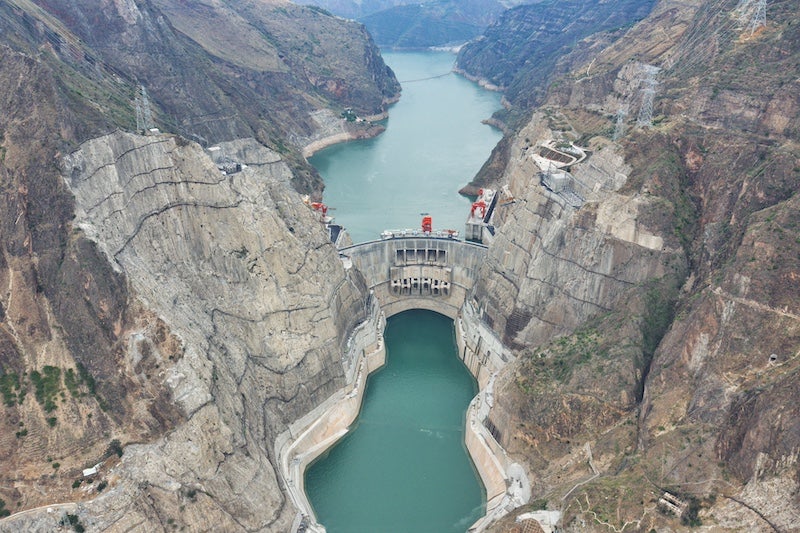
Isimba Dam, Uganda
The Isimba Hydropower Project is a testament to Uganda’s commitment to addressing its power shortages and fostering economic growth. Situated approximately 50km downstream of Jinja on the White Nile River, this run-of-the-river hydroelectric plant was commissioned in March 2019 and has since become an integral part of the country’s energy infrastructure.
The dam boasts an impressive installed capacity of 183.2MW, generated by four vertical Kaplan turbine-generator units. Each of these units is capable of producing 45.8MW, operating at a gross head of 15.4m and an average flow rate of 1,375 cubic meters per second. This configuration allows the project to generate an estimated 1,039 GWh of electricity annually, significantly boosting Uganda’s total electric capacity by 23%.
The dam’s structure is a marvel of engineering, consisting of two primary components. On the left bank stands a concrete gravity dam, measuring 14m in height and stretching 314m in length. Complementing this is a rock-fill embankment dam on the right bank, reaching a maximum height of 26.5m. While the concrete dam serves as the main reservoir retaining structure, the rock-fill dam houses essential emergency gates and stop logs.
In terms of land use, the Isimba project extends over approximately 2,867.6 acres. At its maximum flooding level, the reservoir can stretch up to 5.7km upstream, potentially impacting the Kalagala Falls site area. This expansive footprint underscores the project’s scale and its potential environmental implications.
The power generated at Isimba is transmitted to the national grid via a 42-kilometer-long 132kV double-circuit transmission line, connecting to the Bujagali hydropower station. This integration into the national power infrastructure is facilitated by the Isimba substation, which features a double busbar configuration. The substation includes two line bays, four transformer bays, one bus coupler, and two future bays, ensuring efficient power distribution and allowing for future expansion.
Environmental and social considerations were paramount in the development of the Isimba Hydropower Project. An Environmental and Social Impact Assessment (ESIA) addendum was prepared to address key issues raised by the National Environmental Management Authority (NEMA), particularly concerning the Kalagala Offset Area. The construction of the dam has had significant effects on the local ecosystem and communities, including the flooding of the home of the Budhagaali spirit, an important water spirit in the Busoga Kingdom’s culture. To mitigate these impacts, a comprehensive Community Development Action Plan (CDAP) was implemented, which included the construction of medical centers, schools, and public toilets.
From an economic perspective, the Isimba Hydropower Project represents a substantial investment of approximately $567.7 million. This funding was secured through a combination of government contribution ($85 million) and a loan from the Export-Import Bank of China ($482.5 million). The project is expected to generate electricity at a competitive rate of 68 cents per kWh, positioning it as the lowest-cost producer in East Africa.
Beyond power generation, the project has yielded significant socio-economic benefits. During its construction phase, it created approximately 1000 jobs, contributing to local employment and skill development. Furthermore, the project included the construction of the Isimba Public Bridge, enhancing transportation links between the Kayunga and Kamuli districts and fostering regional connectivity.
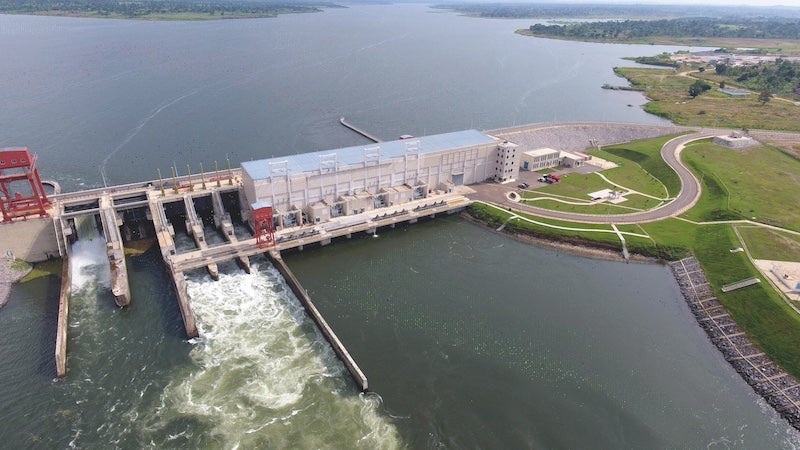
Laúca Dam, Angola
The Laúca project is located on the Kwanza River in Angola. Commissioned in stages between 2017 and 2020, this run-of-the-river hydroelectric project boasts a total capacity of 2070MW, making it the second-largest hydroelectric facility in Africa, after the 2075MW Cahora Bassa power station in Mozambique.
The project features a 132m-high roller compacted concrete (RCC) dam with a crest length of approximately 1075m. This massive structure creates a reservoir with a capacity of 5,482 million cubic meters, spanning an area of nearly 200km2.
At the heart of the Laúca power plant are six main vertical axis Francis turbines, each with a capacity of 334 MW. These turbines operate at a net head of 200m with a nominal flow rate of 182 cubic meters per second. The main powerhouse, measuring 273m in length and 21min width, is constructed underground to house these turbine units.
In addition to the main powerhouse, the project includes an ecological power plant with a capacity of 65.5MW, situated at the base of the dam. This smaller plant features a single vertical axis Francis turbine operating with a nominal flow rate of 60 cubic meters per second and a net head of 128m.
The Laúca plant’s design incorporates advanced features for efficient water management and power generation. The water conveying system comprises six water intakes and six wells, each with an inner diameter of 7m. The spillway is designed to handle a flow rate of 10,020 cubic meters per second, ensuring the dam’s safety during high water events.
Power evacuation from the main plant is achieved through a 400 kV transmission line, while a separate 220 kV ancillary substation handles power from the ecological plant. This robust transmission infrastructure enables the Laúca plant to supply electricity to approximately 8 million Angolan households and contribute significantly to the country’s power grid stability.
The plant’s annual electricity generation capacity is estimated at 8,640 GWh, a substantial contribution to Angola’s energy mix. This output has played a crucial role in reducing power shortages and eliminating the need for daily power rotations in Luanda, the capital city.
Technologically, the Laúca plant incorporates modern control and monitoring systems. The ANDRITZ Metris DiOMera system enables remote monitoring and enhanced functionality, including predictive maintenance capabilities. This advanced system allows for efficient plant management and can potentially extend maintenance intervals, resulting in both environmental and economic benefits.
The construction of the Laúca Hydroelectric Power Plant represented a significant investment of approximately $4.3 billion. This funding was secured through a combination of government investment and international financial institutions, including the Development Bank of Southern Africa, Standard Chartered, and Gemcorp Capital.
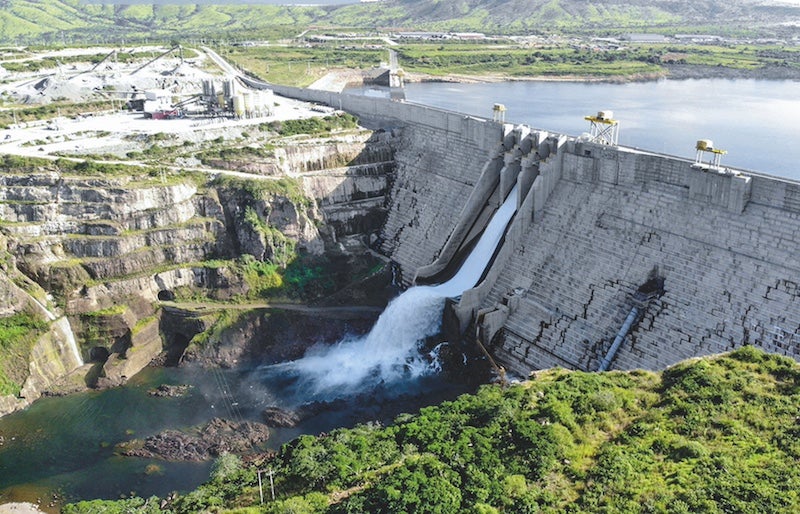
Ilisu Dam, Turkey
The Ilısu Dam, located on the Tigris River in southeastern Turkey, was commissioned in stages between 2019 and 2020. This concrete-faced rockfill dam is a key component of the Southeastern Anatolia Project (GAP), which aims to develop the country’s southeastern provinces.
The dam’s structure has a height of 135m and a crest length of 1820 m. Its embankment volume is a staggering 43.8 million cubic meters, creating a reservoir with a capacity of 10.4 billion cubic meters at maximum storage. This vast reservoir covers an area of approximately 313 square kilometers when at its normal elevation of 525m above sea level.
At the heart of the Ilısu project is its powerhouse, equipped with six vertical Francis turbines, each with a capacity of 200MW. These turbines, coupled with generators rated at 223 MVA, give the dam a total installed capacity of 1200MW. The power plant is designed to generate an impressive 3,833GWh of hydroelectric energy annually, operating at a gross hydraulic head of 122.6m.
The dam’s spillway, crucial for flood control and water management, is located on the right bank and is controlled by eight radial gates. These gates direct water into four chutes before it reaches a plunge pool, ensuring controlled water release when necessary.
To facilitate construction and river diversion, the project included three circular diversion tunnels, each with an inner diameter of 12m and lengths varying from 897 to 1,099m. The tailrace tunnel, approximately 1,100m long with a maximum width of 143m, channels water away from the turbines.
Power transmission from the Ilısu Dam is accomplished through a sophisticated system. The transformer unit includes 18 single-phase step-up transformers and one spare, converting the energy from the turbines to 380 kV. This high-voltage electricity is then transmitted to the switchyard via a 900-meter overhead transmission line. The 380kV switchyard feeds electricity to both a 380kV grid and a 154kV grid through two coupling transformers.
The project incorporates modern control and monitoring systems which enables remote monitoring and predictive maintenance capabilities. This advanced technology enhances the dam’s operational efficiency and potentially extends maintenance intervals.
Construction of the Ilısu Dam faced numerous challenges and controversies, particularly regarding its environmental and cultural impacts. The project necessitated the relocation of the ancient town of Hasankeyf and its historical artifacts, sparking international debate and opposition.
Despite these challenges, the dam began filling its reservoir in late July 2019. By April 2020, it had stored 5 billion cubic meters of water, with water levels reaching 498.2m above the river bed. The first of six generators was commissioned on May 19, 2020, marking a significant milestone in the project’s completion.
The Ilısu Dam represents a major investment in Turkey’s energy infrastructure, with a total project cost estimated at approximately €1.2 billion.
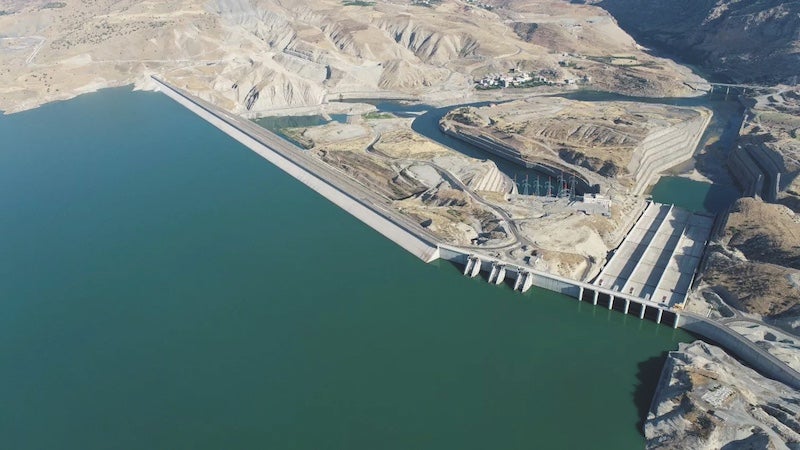
Lower Sesan 2, Cambodia
The Lower Sesan 2 Dam is a significant hydroelectric project located in northeastern Cambodia, situated on the Sesan River in Stung Treng Province. Commissioned in stages between 2017 and 2018, the project represents a key component of Cambodia’s energy development strategy.
The dam has a length of 6.5km, making it one of the longest dams in Asia. It stands 75m high and has a crest width of 8m. The main dam is primarily an earthen structure, with a reinforced concrete section facing the river. This design allows the dam to create a vast reservoir with a storage capacity of 2.72 billion cubic meters, covering an area of approximately 33,560 hectares when at full capacity.
At the heart of the Lower Sesan 2 project is its powerhouse, equipped with eight turbines, each with a capacity of 50MW, giving the dam a total installed capacity of 400MW. These turbines are designed to generate about 1,998 GWh of electricity annually, contributing nearly 20% of Cambodia’s total domestic electricity generation as of 2020.
The project includes several key components beyond the main dam structure. A rectangular span structure with dimensions of 15m x 16m and 12 gates manages water flow according to hydrological analysis. The power plant, situated on the left bank, houses the turbines and associated equipment. Additional infrastructure includes water inlets, shutter valves, a 220kV switchyard, tailrace drains, and administrative buildings.
Construction of the Lower Sesan 2 Dam required extensive earthworks and resource extraction. The project utilized land and rock excavation sites within the reservoir area. Sand extraction occurred at two locations: one 500 meters behind the dam and another on the Srepok River, more than 3km in front of the dam. The project also incorporated comprehensive waste management systems, including landfills, sewage treatment facilities, and water purification systems for worker accommodation.
The dam’s development and operation are managed by Hydro Power Lower Sesan 2 Company Limited, a joint venture comprising Hydro Lancang International Energy (a subsidiary of China Huaneng Group) with a 51% stake, Royal Group of Cambodia with 39%, and Electricity Vietnam International holding the remaining 10%.
Financially, the Lower Sesan 2 project represented a significant investment, with total costs estimated at $781 million to $978 million. This funding was secured through a combination of equity investment from the developers and financing from Chinese banks, including the Industrial and Commercial Bank of China, Bank of China, China Development Bank, and Export–Import Bank of China.
The project operates under a 45-year build-operate-transfer (BOT) agreement, which includes the initial five-year construction period. After 40 years of commercial operation, ownership will be transferred to the Cambodian government.
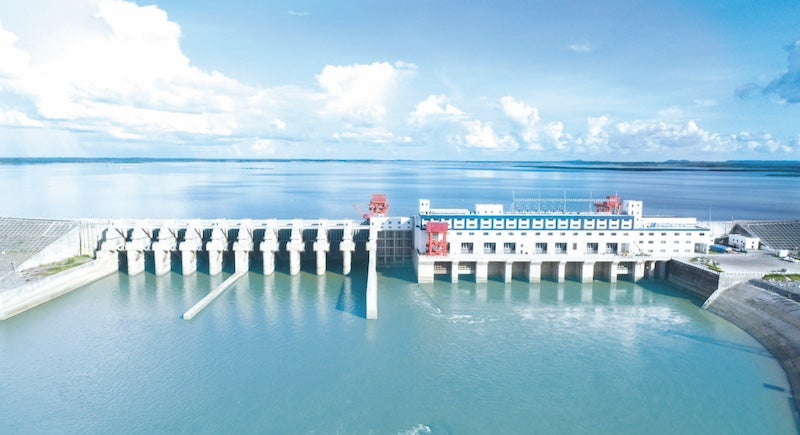
Alto Tâmega, Portugal
The Alto Tâmega Dam is a significant hydroelectric project located on the Tâmega River in northern Portugal, forming part of the larger Tâmega Electricity-Generating Group. This impressive infrastructure is situated in the municipalities of Ribeira de Pena and Vila Pouca de Aguiar, within the Vila Real District.
The dam’s structure is a marvel of engineering, classified as a concrete double curvature arch dam. It stands at a height of 106.5m and stretches 334m in length across the river valley. This design allows for efficient water retention while minimizing the amount of concrete required, making it both economical and structurally sound.
The reservoir created by the Alto Tâmega Dam covers a substantial surface area of 7.4 square kilometers. This large body of water not only serves as a source for power generation but also has the potential to impact local ecosystems and provide opportunities for water management in the region.
Alto Tâmega powerhouse is equipped with two 8 MW turbine units. These units have a combined installed capacity of 160 MW, capable of generating approximately 139 GWh of electricity annually. This significant power output contributes to Portugal’s renewable energy goals and helps meet the country’s growing electricity demands.
The dam’s design incorporates advanced flood control measures, featuring two lateral spillways with a combined discharge capacity of 1,825 cubic meters per second. This impressive flow rate ensures the dam’s safety during high water events, protecting both the structure itself and downstream areas from potential flooding.
Construction of the Alto Tâmega Dam has been a massive undertaking, requiring approximately 220,000 cubic meters of concrete. This substantial amount of material reflects the scale and complexity of the project. The dam’s crest length of 335 m further emphasizes its imposing presence in the landscape.The Alto Tâmega project is part of a larger hydroelectric complex developed by Iberdrola under a 70-year concession agreement signed with the Portuguese government in July 2014. This agreement covers the design, construction, and operation of three interconnected projects: Alto Tâmega, Daivões, and Gouvães dams.
The construction of the Alto Tâmega Dam has been a significant undertaking, employing a peak workforce of almost 1,000 workers on site. This project not only contributes to Portugal’s energy infrastructure but also has provided substantial employment opportunities in the region.
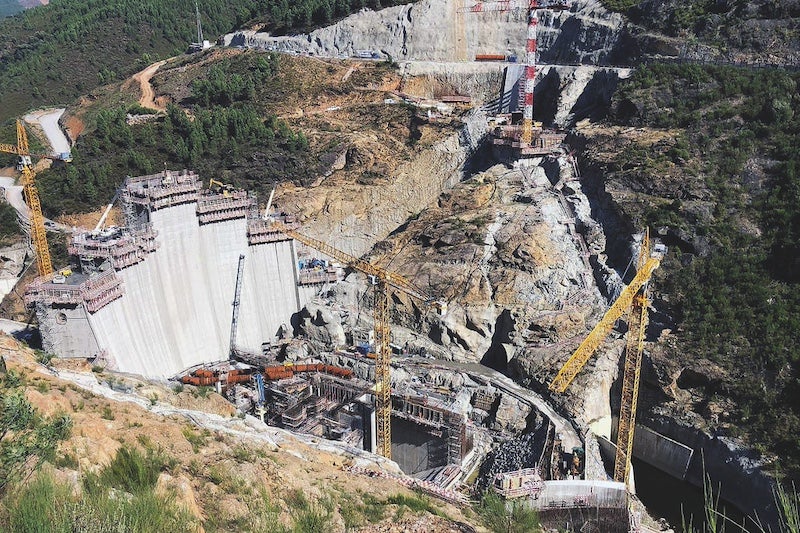
Daivões, Portugal
The Daivões Dam is classified as an arch-gravity concrete dam, combining the structural advantages of both arch and gravity dam designs. It stands at a height of 77.5m and stretches 264m in length across the river valley. This substantial structure required approximately 240,000 cubic meters of concrete during its construction, highlighting the scale of the engineering involved.
The reservoir created by the Daivões Dam covers a surface area of 176 hectares, serving as a crucial water storage facility for power generation. This reservoir not only supports the dam’s own power generation capabilities but also plays a vital role in the operation of the larger Tâmega complex.
At the heart of the Daivões project is its powerhouse, which is semi-buried to minimize environmental impact. The generating unit consists of two Francis turbines, each with a capacity of 59MW, giving the dam a total installed capacity of 118 MW. These turbines are designed to handle a maximum flow rate of 220 cubic meters per second, enabling the dam to produce approximately 159 GWh of electricity annually.
One of the key features of the Daivões Dam is its spillway, which is located over the dam body. The spillway consists of four radial gates, each measuring 11.5m in width and 9m in height. This configuration allows for a maximum discharge capacity of 3,400 cubic meters per second, ensuring the dam’s safety during high water events and providing effective flood control for downstream areas.
The Daivões Dam also serves a crucial role in the operation of the larger Tâmega complex. It functions as the lower reservoir for the 880MW Gouvães Hydro-Electric Pumped Power Station. This interconnection allows for efficient energy storage and management within the complex, enhancing the overall flexibility and reliability of the system.
Construction of the Daivões Dam was a significant undertaking, involving not only the dam structure itself but also associated infrastructure. The project included the construction of a bridge approximately 200m long and 35 m high, more than 5km of power lines, over 7km of roads, and two sewage treatment plants. These additional components highlight the comprehensive nature of the project and its impact on local infrastructure.
The first filling of the Daivões reservoir was completed in March 2021, marking a significant milestone in the project’s development. This event paved the way for the subsequent testing and commissioning phases of the power generation equipment.
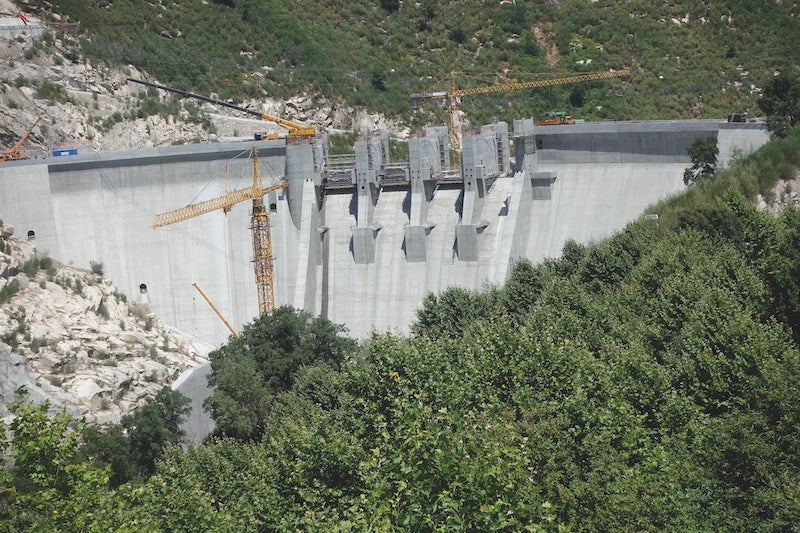
Gouvães, Portugal
The Gouvães Dam is a 35m-high rockfill dam constructed on the River Torno, a tributary of the Tâmega River. Its reservoir covers a substantial surface area of 340 hectares, serving as the upper reservoir for the complex’s pumped storage system. This large body of water not only supports power generation but also provides opportunities for efficient energy storage and management within the larger Tâmega complex.
At the heart of the Gouvães project is its underground powerhouse, a marvel of engineering designed to minimize environmental impact. The generating unit is housed in a cavern measuring 120m in length, 20m in width, and 44m in height. Adjacent to this is a transformer hall with dimensions of 80m by 17m by 14m. This underground configuration allows for a significant power generation capacity while preserving the natural landscape above ground.
The Gouvães power plant is equipped with four reversible turbine units, each with a capacity of 220MW, giving the facility a total installed capacity of 880MW. These Francis turbines are impressive in scale, with a runner diameter of 3500mm and operating at a speed of 600 rpm. The plant is designed to handle a maximum head of 700m, showcasing the significant elevation difference utilized for power generation.
The dam’s spillway, located on the left side of the structure, has a maximum discharge capacity of 67 cubic meters per second, ensuring effective flood control and dam safety. The project also includes 6.5km of tunnels and a 750m shaft, highlighting the complex underground infrastructure required for this type of hydroelectric facility.
A notable feature of the Gouvães project is its penstock – a concrete tunnel with a length of 4.7km and a diameter of 7.3m. This massive conduit is responsible for conveying water between the upper reservoir and the powerhouse, playing a crucial role in both generation and pumping modes.
Construction of the Gouvães Dam was a massive undertaking, estimated to be completed in 47 months. The project required approximately 660 tonnes of steel, part of the total 2,440 tonnes used across the entire Tâmega complex.
